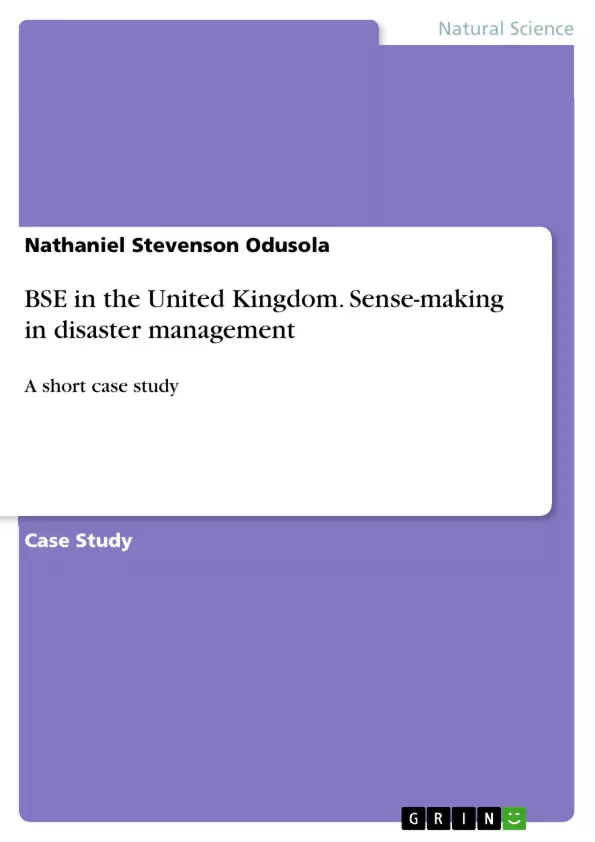The argument of this case study is to re-echo the importance of sense-making, communication and resilience to disaster risk management. It is a critical analysis of sense-making of the BSE in the United Kingdom.
The words ‘mad cow disease’ was first made by David Brown of Daily Telegraph in 2008. The mad cow disease was first documented in Southeast England in 1985 when a farm in the region was afflicted by the disease which led to the loss of Sheep on the farm. In 1987 the disease was said to have spread to cattle. The disease was documented initially as bovine spongiform encephalopathy BSE. The disease affects the central nervous system of an adult cow; also known as ‘bovine spongiform results into cows' aggression and lack of coordination due to the influence of the disease in the brain of the cow. The description of the disease has a sponge-like appearance when examined in the brain of the cow. If and when consumed by humans, it can cause ‘variant Creutzfeldt-Jakob Disease’.
The function of resilience in disaster risk management cannot is necessary due to the extended memory that disaster leaves in the minds of the victims. Resilience played a vital role in the case of the farmers and global community that witnessed the outbreak of the BSE. The desire to increase agricultural production led to the innovation of using several unwholesome technics. This development, however, did not slow down the resilience of the people of the UK. The government adopted policies that could tackle agricultural diseases such as the BSE.
Inhaltsverzeichnis (Table of Contents)
- INTRODUCTION:
- History of the Mad Cow Disease:
- SENSE-MAKING AS TOOL TO DISASTER RISK MANAGEMENT.
- The Role of Effective Communication and Symbolism to Disaster Risk Management:
- The Role of Resilience to Disaster Risk Management...
- CONCLUSION:
Zielsetzung und Themenschwerpunkte (Objectives and Key Themes)
This case study examines the critical role of sense-making, communication, and resilience in effective disaster risk management, specifically focusing on the BSE crisis in the United Kingdom. It aims to highlight the need for robust mechanisms to manage public panic and ensure efficient resource allocation during crises.
- The importance of sense-making in disaster risk management.
- The role of effective communication in mitigating disaster risk.
- The significance of resilience in responding to and recovering from disasters.
- The BSE crisis as a case study for analyzing disaster risk management strategies.
- The impact of the BSE crisis on public perception and the UK's food safety policies.
Zusammenfassung der Kapitel (Chapter Summaries)
- INTRODUCTION: This chapter introduces the case study by outlining its arguments and defining the key concepts of sense-making, communication, and resilience. It provides a brief history of the Mad Cow Disease (BSE), its origins, and its impact on human health.
- History of the Mad Cow Disease: This chapter details the emergence and spread of BSE in the UK, focusing on the government's response and the shortcomings in its disaster management strategy. It examines the Philips Inquiry report and its findings regarding the inadequacy of sense-making and communication in the crisis.
- SENSE-MAKING AS TOOL TO DISASTER RISK MANAGEMENT: This chapter explores the concept of sense-making in the context of disaster risk management. It discusses the challenges associated with disaster detection, such as organizational incapacity, socio-political factors, and the psychological impact on decision-makers. The chapter advocates for strengthening redundancy networks and leveraging technology and information for effective sense-making.
- The Role of Effective Communication and Symbolism to Disaster Risk Management: This chapter emphasizes the vital role of communication in disaster risk management, highlighting the need for collaborative planning and engagement of stakeholders. It examines the dilemma faced by policymakers in communicating with the public during crises, balancing transparency with the need to manage public panic.
Schlüsselwörter (Keywords)
Key terms and concepts explored in this study include sense-making, communication, resilience, disaster risk management, BSE, Mad Cow Disease, variant Creutzfeldt-Jakob Disease (vCJD), food safety, public panic, government response, and crisis management.
- Arbeit zitieren
- Nathaniel Stevenson Odusola (Autor:in), BSE in the United Kingdom. Sense-making in disaster management, München, GRIN Verlag, https://www.grin.com/document/899977



